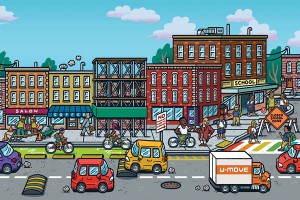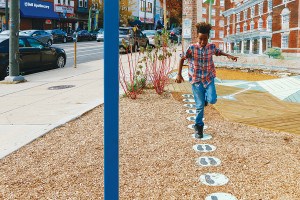The Prodigal Parents: Empty Nesters Are Rejoining Their Adult Children in the City
In 2006, Elizabeth McDonald moved to Bella Vista from River Forest, Ill.
Last month, her parents followed her.
Elizabeth grew up in River Forest, a suburb right outside Chicago, met her husband after returning there for a post-college year, and took a job as a teacher at Loomis Elementary in Broomall. The older McDonalds came to know the city through visits to their daughter. They enjoyed its vibrancy, its metropolitan je ne sais quoi, and so on.
“We became very familiar with Philadelphia and thought, my gosh, we would really like to live here,” said Elizabeth’s father, John. He taught at Roosevelt University in Chicago, and after retiring, found himself living in a place without a purpose to live there. In June, he and his wife Glena moved to Center City apartment building the Drake, a mile away from his daughter, and they see her a couple times a week.
Elizabeth and her husband have no children, and I asked her if she planned on staying in the city should they have any. “The schools are a big concern,” he said. “We want to stay in the city for now. Who knows what they’ll be like however many years from now?” Even by the time she and her husband arrived, in the era of Paul Vallas, the district was facing a $75 million shortfall, which now feels like pocket change compared to today’s apocalyptic $304 million deficit and mass school closure.
So if they leave, she said, it would be because of the schools. “We love it here,” she said. “We love being able to walk everywhere. A lot of friends live close by. We love the Philly lifestyle. I feel like it would be really hard to give up that lifestyle.”
John sold the family’s house in River Forest and he and Glena rent at the Drake. I asked John if he knew of any other parents who moved to the same city as their children. “You know, it’s funny you say that,” he said. “The folks who bought our house are moving there from an outer suburb to be close to their daughter and son-in-law who lived in downtown Chicago and who moved to River Forest when they had a child.”
***
The demographic isn’t new: Stir-crazy Boomers hungry for cosmopolitanism flock to the cities they and their parents once fled. They’ve been returning to the city since at least the beginning of the 2000s. The small real estate empires dominating Center City’s skyline were, for the most part, bankrolled by suburbanites who realized the houses they were living in were now suddenly too big — and, pre-recession, sold those houses for cash and traded them in for one of Carl Dranoff et al.’s six-figure-plus condos.
But real estate agents and property developers say the 55-and-up demographic aren’t just moving to any old city, but are increasingly moving to the cities occupied by their kids — the same 20- and 30-somethings who have dominated the narrative of urban re-migration are also bringing their parents with them. The more of them that have moved to Philly, the more their parents have followed, effectively relocating the entire nucleus of the family. And this flock of empty nesters isn’t necessarily landing solely in the city’s condo core. They’re also moving to neighborhoods that an ever-expanding Center City District is gradually absorbing, like Graduate Hospital and parts of South Philly.
“We’ve already cycled into a new era from the Symphony House era,” Inquirer architecture critic Inga Saffron tells me. That era, of glamorous high-rises catering to bored empty nesters, has given way to a more moderate method of relocation. Empty nesters are now either moving into other neighborhoods or renting the high-rises for which they once shelled out cash.
“We just generally thought it would be a more interesting place to be,” said Rick Harris, who moved with his wife Maryanne to a house in Fishtown in January. Their son, Patrick, had moved to South Philly three years ago and bought a house with his wife. Rick says that they’ve enjoyed going to the museums. Maryanne says she appreciates the density of health care in the city after suffering from pancreatitis.
Their house in Fishtown has an interior suburban décor — lace, tchotchkes decorated with flowers — with the hip offset of an exposed brick wall. As Rick was explaining how his job had tethered him to Upstate New York for the past few years, Patrick walked in. “You have something specific or did you come just to hang out?” Rick asked.
“I just came to get my big jar of change,” said Patrick.
“It’s behind the speaker against the wall.”
“You want your airplane pillow? That’s in the laundry room,” said Maryanne.
“America isn’t a country of family values; Mexico is a country of family values,” wrote Richard Rodriguez. “This is a country where people leave home.” In a way, it’s a reversal of one of the most fundamental concepts of American mobility — or if not a reversal, then a full circle, a hypermobility where even the individual members of the family itself are synchronized in their nomadism. People like Patrick, tattooed, clad in a cutoff denim vest with a band patch sewn to the back, leave home, not anticipating that years later they’ll be stopping into their parents’ house a few neighborhoods away to pick up their airplane pillows.
***
In early July, Saffron wrote about a group of anomalous 25- to 44-year-olds in the Graduate Hospital neighborhood who formed the nonprofit Friends of Chester Arthur Elementary School, which as of the publication of the article, had raised $350,000 to compensate for the catastrophic budget cuts facing the school. The group was determined to not repeat the tradition of fleeing to the suburbs when the kids came of age. Instead, they defiantly stayed put.
The city’s growth, says Janice Madden of the University of Pennsylvania’s Center for Population studies, has been most marked in the 15-24 and 55-64 age ranges — that is, restless young people and their restless parents. But the 25-44-year-old age range is still leaving.
Next year, Brian DeHaven’s parents will move to 2400 South St., eight years after he moved to Graduate Hospital; and by the time they move to South Street, he will have moved to Haverford. DeHaven participated in the Chester Arthur nonprofit, helping it raise money (GradHo is in the Chester Arthur catchment) in a last-ditch effort to not have to move to the suburbs as their children near school-age. They tried looking in West Philly to be near Penn Alexander, but couldn’t find a suitable house and finally decided the best thing to do was to move.
“It originally was a really, really hard decision, and I was really sad about it,” said DeHaven. “I was bragging to people, we’re always going to live in the city, and we’re not going to be like our parents and flee to the suburbs. I had to eat all those words.”
DeHaven seems genuine about it; he seems to be paying more than lip service to the idea of remaining in the city, and when we speak, there’s a sense of regret, almost even shame for fleeing the place he claimed to love, and for having to eat all those words.
***
The continued in-migration of empty nesters is an unqualified economic boon for Philadelphia, a demographic in many ways coveted as much as young college grads. Unlike the 20-somethings, the 50-plus group has more disposable cash, more leisure time; they have 401ks and Roth IRAs accrued over a lifetime to dump into the city’s coffers. Even channeling federal Medicare dollars into the local health systems helps.
But it’s too soon to see if their reintroduction here will be enough to financially offset the continuing exodus of young parents like DeHaven, if the combined influx of empty nesters and college students will prove sufficient to end the nagging prisoner’s dilemma that the demographic between recent grads and retirees has faced for the past few decades: If everyone stays, the schools get better, and if most of them leave and a few young parents stay, the stayers subject their children to schools capable of psychological annihilation.
By following their children, the empty nesters represent the gradual reintroduction of well-to-do families living in Philadelphia as families, not fractured by place, the way they used to in the city’s earlier days and how families had done for centuries before that. It’s as if the same people who fled from the city in the first place have become exhausted of all the possibilities of American mobility.
“It’s sad,” DeHaven tells me. “I’m not happy I’m moving. I wouldn’t have traded living here for anything, and I worry that on some level it’s a playground, and then you’re still going to be losing that middle class and upper middle class group of people.”
DeHaven, of course, is referring to the city as a playground for adults, a kind of cluster of amenities that differs from the suburbs only in density, one with more cafes and healthcare and je ne sais quoi — a place that’s fun, that people love, right before they leave.
Andrew Thompson is a freelance writer and a contributor to The Philly Post. Reach him at andrewscottthompson@gmail.com or on Twitter at @asthompson


